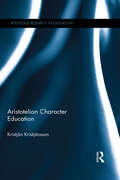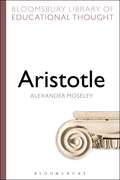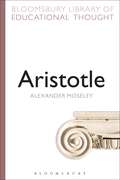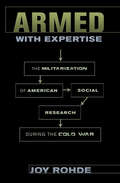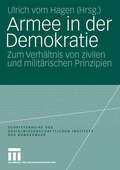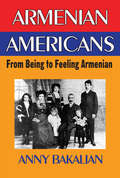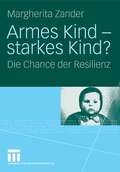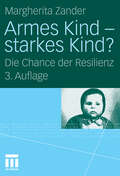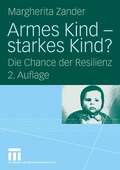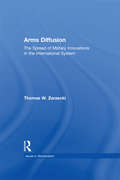- Table View
- List View
Aristotelian Character Education (Routledge Research in Education)
by Kristján KristjánssonThis book provides a reconstruction of Aristotelian character education, shedding new light on what moral character really is, and how it can be highlighted, measured, nurtured and taught in current schooling. Arguing that many recent approaches to character education understand character in exclusively amoral, instrumentalist terms, Kristjánsson proposes a coherent, plausible and up-to-date concept, retaining the overall structure of Aristotelian character education.After discussing and debunking popular myths about Aristotelian character education, subsequent chapters focus on the practical ramifications and methodologies of character education. These include measuring virtue and morality, asking whether Aristotelian character education can salvage the effects of bad upbringing, and considering implications for teacher training and classroom practice. The book rejuvenates time-honoured principles of the development of virtues in young people, at a time when ‘character’ features prominently in educational agendas and parental concerns over school education systems.Offering an interdisciplinary perspective which draws from the disciplines of education, psychology, philosophy and sociology, this book will appeal to researchers, academics and students wanting a greater insight into character education.
Aristotle (Bloomsbury Library of Educational Thought)
by Alexander MoseleyAristotle is often underrated in educational circles but the impact of his philosophy and his actions are evident in the schools and universities around us today. Aristotle developed the first proper university that had different departments and vast collections of texts and artefacts. His philosophy has also influenced the greatest minds since his time, from Aquinas to today's logicians, rationalists, and empiricists. The influence of his educational thinking and his philosophy in general helped underpin the Renaissance and the modern era. In a nutshell, Aristotle took our thinking and said, 'make it sharper.' Alexander Moseley offers a thorough and comprehensive overview of the works of Aristotle and explores the influence of his thought and writings and their impact on our education systems today.
Aristotle (Continuum Library of Educational Thought)
by Alexander Moseley Richard BaileyAristotle is often underrated in educational circles but the impact of his philosophy and his actions are evident in the schools and universities around us today. Aristotle developed the first proper university that had different departments and vast collections of texts and artefacts. His philosophy has also influenced the greatest minds since his time, from Aquinas to today's logicians, rationalists, and empiricists. The influence of his educational thinking and his philosophy in general helped underpin the Renaissance and the modern era. In a nutshell, Aristotle took our thinking and said, 'make it sharper.' Alexander Moseley offers a thorough and comprehensive overview of the works of Aristotle and explores the influence of his thought and writings and their impact on our education systems today.
Armageddon in Waco: Critical Perspectives on the Branch Davidian Conflict
by Stuart A. WrightOn February 28, 1993, the United States Bureau of Alcohol, Tobacco, and Firearms (BATF) launched the largest assault in its history against a small religious community in central Texas. One hundred agents armed with automatic and semi automatic weapons invaded the compound, purportedly to execute a single search and arrest warrant. The raid went badly; four agents were killed, and by the end of the day the settlement was surrounded by armored tanks and combat helicopters. After a fifty-one day standoff, the United States Justice Department approved a plan to use CS gas against those barricaded inside. Whether by accident or plan, tanks carrying the CS gas caused the compound to explode in fire, killing all seventy-four men, women, and children inside. Could the tragedy have been prevented? Was it necesary for the BATF agents to do what they did? What could have been done differently? Armageddon in Waco offers the most detailed, wide-ranging analysis of events surrounding Waco. Leading scholars in sociology, history, law, and religion explore all facets of the confrontation in an attempt to understand one of the most confusing government actions in American history. The book begins with the history of the Branch Davidians and the story of its leader, David Koresh. Chapters show how the Davidians came to trouble authorities, why the group was labeled a "cult," and how authorities used unsubstantiated allegations of child abuse to strengthen their case against the sect. The media's role is examined next in essays that considering the effect on coverage of lack of time and resources, the orchestration of public relations by government officials, the restricted access to the site or to countervailing evidence, and the ideologies of the journalists themselves. Several contributors then explore the relation of violence to religion, comparing Waco to Jonestown. Finally, the role played by "experts" and "consultants" in defining such conflicts is explored by two contributors who had active roles as scholarly experts during and after the siege The legal and consitutional implications of the government's actions are also analyzed in balanced, clearly written detail.
Armageddon in Waco: Critical Perspectives on the Branch Davidian Conflict
by Stuart A. WrightOn February 28, 1993, the United States Bureau of Alcohol, Tobacco, and Firearms (BATF) launched the largest assault in its history against a small religious community in central Texas. One hundred agents armed with automatic and semi automatic weapons invaded the compound, purportedly to execute a single search and arrest warrant. The raid went badly; four agents were killed, and by the end of the day the settlement was surrounded by armored tanks and combat helicopters. After a fifty-one day standoff, the United States Justice Department approved a plan to use CS gas against those barricaded inside. Whether by accident or plan, tanks carrying the CS gas caused the compound to explode in fire, killing all seventy-four men, women, and children inside. Could the tragedy have been prevented? Was it necesary for the BATF agents to do what they did? What could have been done differently? Armageddon in Waco offers the most detailed, wide-ranging analysis of events surrounding Waco. Leading scholars in sociology, history, law, and religion explore all facets of the confrontation in an attempt to understand one of the most confusing government actions in American history. The book begins with the history of the Branch Davidians and the story of its leader, David Koresh. Chapters show how the Davidians came to trouble authorities, why the group was labeled a "cult," and how authorities used unsubstantiated allegations of child abuse to strengthen their case against the sect. The media's role is examined next in essays that considering the effect on coverage of lack of time and resources, the orchestration of public relations by government officials, the restricted access to the site or to countervailing evidence, and the ideologies of the journalists themselves. Several contributors then explore the relation of violence to religion, comparing Waco to Jonestown. Finally, the role played by "experts" and "consultants" in defining such conflicts is explored by two contributors who had active roles as scholarly experts during and after the siege The legal and consitutional implications of the government's actions are also analyzed in balanced, clearly written detail.
Armageddon in Waco: Critical Perspectives on the Branch Davidian Conflict
by Stuart A. WrightOn February 28, 1993, the United States Bureau of Alcohol, Tobacco, and Firearms (BATF) launched the largest assault in its history against a small religious community in central Texas. One hundred agents armed with automatic and semi automatic weapons invaded the compound, purportedly to execute a single search and arrest warrant. The raid went badly; four agents were killed, and by the end of the day the settlement was surrounded by armored tanks and combat helicopters. After a fifty-one day standoff, the United States Justice Department approved a plan to use CS gas against those barricaded inside. Whether by accident or plan, tanks carrying the CS gas caused the compound to explode in fire, killing all seventy-four men, women, and children inside. Could the tragedy have been prevented? Was it necesary for the BATF agents to do what they did? What could have been done differently? Armageddon in Waco offers the most detailed, wide-ranging analysis of events surrounding Waco. Leading scholars in sociology, history, law, and religion explore all facets of the confrontation in an attempt to understand one of the most confusing government actions in American history. The book begins with the history of the Branch Davidians and the story of its leader, David Koresh. Chapters show how the Davidians came to trouble authorities, why the group was labeled a "cult," and how authorities used unsubstantiated allegations of child abuse to strengthen their case against the sect. The media's role is examined next in essays that considering the effect on coverage of lack of time and resources, the orchestration of public relations by government officials, the restricted access to the site or to countervailing evidence, and the ideologies of the journalists themselves. Several contributors then explore the relation of violence to religion, comparing Waco to Jonestown. Finally, the role played by "experts" and "consultants" in defining such conflicts is explored by two contributors who had active roles as scholarly experts during and after the siege The legal and consitutional implications of the government's actions are also analyzed in balanced, clearly written detail.
Armageddon in Waco: Critical Perspectives on the Branch Davidian Conflict
by Stuart A. WrightOn February 28, 1993, the United States Bureau of Alcohol, Tobacco, and Firearms (BATF) launched the largest assault in its history against a small religious community in central Texas. One hundred agents armed with automatic and semi automatic weapons invaded the compound, purportedly to execute a single search and arrest warrant. The raid went badly; four agents were killed, and by the end of the day the settlement was surrounded by armored tanks and combat helicopters. After a fifty-one day standoff, the United States Justice Department approved a plan to use CS gas against those barricaded inside. Whether by accident or plan, tanks carrying the CS gas caused the compound to explode in fire, killing all seventy-four men, women, and children inside. Could the tragedy have been prevented? Was it necesary for the BATF agents to do what they did? What could have been done differently? Armageddon in Waco offers the most detailed, wide-ranging analysis of events surrounding Waco. Leading scholars in sociology, history, law, and religion explore all facets of the confrontation in an attempt to understand one of the most confusing government actions in American history. The book begins with the history of the Branch Davidians and the story of its leader, David Koresh. Chapters show how the Davidians came to trouble authorities, why the group was labeled a "cult," and how authorities used unsubstantiated allegations of child abuse to strengthen their case against the sect. The media's role is examined next in essays that considering the effect on coverage of lack of time and resources, the orchestration of public relations by government officials, the restricted access to the site or to countervailing evidence, and the ideologies of the journalists themselves. Several contributors then explore the relation of violence to religion, comparing Waco to Jonestown. Finally, the role played by "experts" and "consultants" in defining such conflicts is explored by two contributors who had active roles as scholarly experts during and after the siege The legal and consitutional implications of the government's actions are also analyzed in balanced, clearly written detail.
Armageddon or Evolution?: The Scientific Method and Escalating World Problems
by Bernard S PhillipsWe are currently experiencing a wide range of evolving problems that threaten us with extinction. However, Phillips argues that we have the capacity-with the aid of a broad approach to the scientific method that builds on Mills's concept of "the sociological imagination"-to confront these problems ever more effectively. This book develops and builds upon new methods for addressing such social problems as global warming, terrorism, growing inequalities, and others. Phillips reveals procedures for achieving conscious evolution by uncovering fundamental assumptions and their contradictions and by moving toward alternative assumptions that promise to resolve these contradictions.
Armageddon or Evolution?: The Scientific Method and Escalating World Problems
by Bernard S PhillipsWe are currently experiencing a wide range of evolving problems that threaten us with extinction. However, Phillips argues that we have the capacity-with the aid of a broad approach to the scientific method that builds on Mills's concept of "the sociological imagination"-to confront these problems ever more effectively. This book develops and builds upon new methods for addressing such social problems as global warming, terrorism, growing inequalities, and others. Phillips reveals procedures for achieving conscious evolution by uncovering fundamental assumptions and their contradictions and by moving toward alternative assumptions that promise to resolve these contradictions.
Armed and Considered Dangerous: A Survey of Felons and Their Firearms
by Peter H. RossiArmed and Considered Dangerous is a book about "bad guys" and their guns. But Wright and Rossi contend that for every suspected criminal who owns and abuses a firearm, a hundred or more average citizens own guns for sport, for recreation, for self-protection, and for other reasons generally regarded as appropriate or legitimate. Armed and Considered Dangerous is the most ambitious survey ever undertaken of criminal acquisition, possession, and use of guns.There are vast differences between the average gun owner and the average gun-abusing felon, but the analyses reported here do not suggest any obvious way to translate these differences into gun control policies. Most policy implications drawn from the book are negative in character: this will not work for this reason, that will not work for that reason, and so on. When experts are asked, "Okay, then what will work?" they usually fall back on the old warhorses of poverty, the drug problem, or the inadequate resources of the criminal justice system, and otherwise have little to say. This is not a failure of social science. It simply asks more of the data than the data were ever intended to provide.Several of Wright and Rossi's findings have become "coin of the realm" in the gun control debate, cited frequently by persons who have long since forgotten where the data came from or what their limitations are. Several other findings, including many that are important, have been largely ignored. Still other findings have been superseded by better and more recent data or rendered anachronistic by intervening events. With the inclusion of a new introduction detailing recent statistics and updated information this new edition of Armed and Considered Dangerous is a rich source of information for all interested in learning about weapon behavior and ownership in America.
Armed and Considered Dangerous: A Survey of Felons and Their Firearms (Social Institutions And Social Change Ser.)
by Peter H. RossiArmed and Considered Dangerous is a book about "bad guys" and their guns. But Wright and Rossi contend that for every suspected criminal who owns and abuses a firearm, a hundred or more average citizens own guns for sport, for recreation, for self-protection, and for other reasons generally regarded as appropriate or legitimate. Armed and Considered Dangerous is the most ambitious survey ever undertaken of criminal acquisition, possession, and use of guns.There are vast differences between the average gun owner and the average gun-abusing felon, but the analyses reported here do not suggest any obvious way to translate these differences into gun control policies. Most policy implications drawn from the book are negative in character: this will not work for this reason, that will not work for that reason, and so on. When experts are asked, "Okay, then what will work?" they usually fall back on the old warhorses of poverty, the drug problem, or the inadequate resources of the criminal justice system, and otherwise have little to say. This is not a failure of social science. It simply asks more of the data than the data were ever intended to provide.Several of Wright and Rossi's findings have become "coin of the realm" in the gun control debate, cited frequently by persons who have long since forgotten where the data came from or what their limitations are. Several other findings, including many that are important, have been largely ignored. Still other findings have been superseded by better and more recent data or rendered anachronistic by intervening events. With the inclusion of a new introduction detailing recent statistics and updated information this new edition of Armed and Considered Dangerous is a rich source of information for all interested in learning about weapon behavior and ownership in America.
Armed Forces, Soldiers and Civil-Military Relations: Essays in Honor of Jürgen Kuhlmann (Schriftenreihe des Sozialwissenschaftlichen Instituts der Bundeswehr)
by Gerhard Kümmel Giuseppe Caforio Christopher DandekerIt is an honor for us to introduce this collection of essays, which is dedicated to an old friend and colleague who is no longer with us. It is an honor, but also a pleasure because we feel like continuing a dialogue with Jürgen; one that has never broken down over the years, revisiting and recalling the diff- ent places and occasions where we met, discussed, collaborated and had fun. We, that is, Giuseppe Caforio, Christopher Dandeker and Gerhard Kümmel who have been friends and/or colleagues of and research collaborators with Jürgen and who represent three prominent institutions and organizations with which Jürgen worked, felt that this book is something we owe to Jürgen and we are grateful that many people who at different times and at different places had contact with Jürgen and his work were willing to contribute a chapter to this anthology. Most of Jürgen’s studies, professional work and research activities took place at the Bundeswehr Institute of Social Sciences (SOWI). Jürgen, born in 1938, had joined the Bundeswehr in 1957 and had already worked at the SOWI’s predecessor institution, the Scientific Institute for Education in the Armed Forces from 1971 onwards after having finished his university? st- ies. Since this institute was renamed SOWI in 1974, Jürgen belonged to the first generation of researchers that worked at the SOWI.
Armed Groups in Cambodian Civil War: Territorial Control, Rivalry, and Recruitment (Asia Today)
by Y. KubotaIn civil war the causal mechanism on recruitment of combatants is complicated because armed groups interact for context-based strategic. This book argues that a group will adopt varying mobilization strategies depending upon the difference in a group's influence between the stronghold and contested areas, using as examples two Cambodian civil wars.
Armed with Expertise: The Militarization of American Social Research during the Cold War (American Institutions and Society)
by Joy RohdeDuring the height of the wars in Iraq and Afghanistan, the Pentagon launched a controversial counterinsurgency program called the Human Terrain System. The program embedded social scientists within military units to provide commanders with information about the cultures and grievances of local populations. Yet the controversy it inspired was not new. Decades earlier, similar national security concerns brought the Department of Defense and American social scientists together in the search for intellectual weapons that could combat the spread of communism during the Cold War. In Armed with Expertise, Joy Rohde traces the optimistic rise, anguished fall, and surprising rebirth of Cold War–era military-sponsored social research. Seeking expert knowledge that would enable the United States to contain communism, the Pentagon turned to social scientists. Beginning in the 1950s, political scientists, social psychologists, and anthropologists optimistically applied their expertise to military problems, convinced that their work would enhance democracy around the world. As Rohde shows, by the late 1960s, a growing number of scholars and activists condemned Pentagon-funded social scientists as handmaidens of a technocratic warfare state and sought to eliminate military-sponsored research from American intellectual life. But the Pentagon’s social research projects had remarkable institutional momentum and intellectual flexibility. Instead of severing their ties to the military, the Pentagon’s experts relocated to a burgeoning network of private consulting agencies and for-profit research offices. Now shielded from public scrutiny, they continued to influence national security affairs. They also diversified their portfolios to include the study of domestic problems, including urban violence and racial conflict. In examining the controversies over Cold War social science, Rohde reveals the persistent militarization of American political and intellectual life, a phenomenon that continues to raise grave questions about the relationship between expert knowledge and American democracy.
Armee in der Demokratie: Zum Verhältnis von zivilen und militärischen Prinzipien (Schriftenreihe des Sozialwissenschaftlichen Instituts der Bundeswehr)
by Ulrich HagenInnerhalb der Militärsoziologie besteht der kleinste gemeinsame Nenner in der Feststellung, dass die Herrschafts- und Ordnungsvorstellungen des Militärs von denen ziviler Gesellschaften mehr oder weniger abweichen. Diese Spannung macht das „Militär“ als Dimension sozialwissenschaftlicher Betrachtung der sozialen Welt so interessant. Die Frage der Vereinbarkeit oder Unvereinbarkeit des Gleichheits- und Freiheitspostulats der Demokratie mit militärischen Prinzipien besitzt weitreichende Implikationen für die jeweiligen Gemeinwesen, denn unterschiedliche Demokratiemodelle schreiben dem Militär unterschiedliche Rollen und Funktionen zu. Die für die Ausübung der physischen Gewalt des Staates konzentrierten militärischen Kräfte setzen in Demokratien die symbolische Anerkennung und gesellschaftliche Legitimität der Existenz der Streitkräfte voraus. Da nicht nur das Militär in einer Wechselbeziehung zum Phänomen des Krieges steht, sondern auch die zivile Gesellschaft Verantwortungsträger und Opfer von Kriegen ist, gilt es den Blickwinkel der herkömmlichen Militärsoziologie um diese kriegssoziologischen Aspekte zu erweitern.
Armenian-Americans: From Being to Feeling American
by Anny BakalianAssimilation has been a contentious issues for most immigrant groups in the United States. The host society is assumed to lire immigrants and their descendants away from their ancestral heritage. Yet, in their quest for a "better" life, few immigrants intentionally forsake heir ethnic identity; most try to hold onto their culture by transplanting their traditional institutions and recreating new communities in America. Armenian-Americans are no exception. Armenian-Americans have been generally overlooked by census enumerators, survey analysts, and social scientists because of their small numbers and relative dispersion throughout the United States. They remain a little-studied group that has been called a "hidden minority." Armenian Americans fills this significant gap. Based on the results of an extensive mail questionnaire survey, in-depth interviews, and participant observation of communal gatherings, this book analyzed the individual and collective struggles of Armenian-Americans to perpetuate their Armenian legacy while actively seeking new pathways to the American Dream. This volume shows how men and women of Armenian descent become distanced from their ethnic origins with the passing of generations. Yet assimilation and maintenance of ethnic identity go hand-in-hand. The ascribed, unconscious, compulsive Armenianness of the immigrant generation is transformed into a voluntary, rational, situational Armenianness. The generational change is from being Armenian to feeling Armenian. The Armenian-American community has grown and prospered in this century. Greater tolerance of ethnic differences in the host society, the remarkable social mobility of many Armenian-Americans and the influx of large numbers of new immigrants from the Middle East and Soviet bloc in recent decades have contributed to this development. The future of this community, however, remains precarious as it strives to adjust to the ever changing social, economic, and political conditions affec
Armenian-Americans: From Being to Feeling American
by Anny BakalianAssimilation has been a contentious issues for most immigrant groups in the United States. The host society is assumed to lire immigrants and their descendants away from their ancestral heritage. Yet, in their quest for a "better" life, few immigrants intentionally forsake heir ethnic identity; most try to hold onto their culture by transplanting their traditional institutions and recreating new communities in America. Armenian-Americans are no exception. Armenian-Americans have been generally overlooked by census enumerators, survey analysts, and social scientists because of their small numbers and relative dispersion throughout the United States. They remain a little-studied group that has been called a "hidden minority." Armenian Americans fills this significant gap. Based on the results of an extensive mail questionnaire survey, in-depth interviews, and participant observation of communal gatherings, this book analyzed the individual and collective struggles of Armenian-Americans to perpetuate their Armenian legacy while actively seeking new pathways to the American Dream. This volume shows how men and women of Armenian descent become distanced from their ethnic origins with the passing of generations. Yet assimilation and maintenance of ethnic identity go hand-in-hand. The ascribed, unconscious, compulsive Armenianness of the immigrant generation is transformed into a voluntary, rational, situational Armenianness. The generational change is from being Armenian to feeling Armenian. The Armenian-American community has grown and prospered in this century. Greater tolerance of ethnic differences in the host society, the remarkable social mobility of many Armenian-Americans and the influx of large numbers of new immigrants from the Middle East and Soviet bloc in recent decades have contributed to this development. The future of this community, however, remains precarious as it strives to adjust to the ever changing social, economic, and political conditions affec
Armenian Civil Society: Old Problems, New Energy After Two Decades of Independence (Societies and Political Orders in Transition)
by Yevgenya Paturyan Valentina GevorgyanThis book analyzes Armenian civil society in the context of post-communist democratization. It explores persistent challenges to civic engagement under Armenia’s semi-authoritarian regime, and also highlights success stories of public mobilization and social impact. Drawing on a broad range of methods and empirical sources, the book provides a comprehensive overview of the re-emerging diversity of Armenian civil society: from formal organizations to spontaneous activism. It combines a country-level analysis of broad patterns in the country’s political culture with the life stories of individual agents of change, contrasting public apathy with young activists’ enthusiasm. By exploring mobilization strategies and narratives in Armenian civil society, the book provides valuable new insights into the roots of the mass public uprising in spring 2018.
Armes Kind - starkes Kind?: Die Chance der Resilienz
by Margherita ZanderDas Buch bietet einen fundierten Einblick in die international viel diskutierte und neuerdings auch in Deutschland lebhaft verfolgte Resilienzforschung. „Resilienz“ bedeutet „seelische Widerstandsfähigkeit“ in belasteten und risikobehafteten Lebenssituationen. Aufwachsen in Armut ist ein zentrales Entwicklungsrisiko für Kinder. Wichtigste Erkenntnis ist, dass „Resilienz“durch pädagogisches und sozialpädagogisches Handeln gefördert werden kann. Bisher fehlte jedoch eine theoretisch fundierte Begründung und eine substanzielle fachliche Erörterung, wie sich das Resilienzkonzept für Kinder und Familien in Armutslagen übertragen und anwenden lässt. Diese Lücke schließt das Buch.
Armes Kind - starkes Kind?: Die Chance der Resilienz
by Margherita ZanderDas Buch bietet einen fundierten Einblick in die international viel diskutierte und neuerdings auch in Deutschland lebhaft verfolgte Resilienzforschung. „Resilienz“ bedeutet „seelische Widerstandsfähigkeit“ in belasteten und risikobehafteten Lebenssituationen. Aufwachsen in Armut ist ein zentrales Entwicklungsrisiko für Kinder. Wichtigste Erkenntnis ist, dass „Resilienz“ durch pädagogisches und sozialpädagogisches Handeln gefördert werden kann. Bisher fehlte jedoch eine theoretisch fundierte Begründung und eine substanzielle fachliche Erörterung, wie sich das Resilienzkonzept für Kinder und Familien in Armutslagen übertragen und anwenden lässt. Diese Lücke schließt das Buch.
Armes Kind - starkes Kind?: Die Chance der Resilienz
by Margherita ZanderDas Buch bietet einen fundierten Einblick in die international viel diskutierte und neuerdings auch in Deutschland lebhaft verfolgte Resilienzforschung. „Resilienz“ bedeutet „seelische Widerstandsfähigkeit“ in belasteten und risikobehafteten Lebenssituationen. Aufwachsen in Armut ist ein zentrales Entwicklungsrisiko für Kinder. Wichtigste Erkenntnis ist, dass „Resilienz“ durch pädagogisches und sozialpädagogisches Handeln gefördert werden kann. Bisher fehlte jedoch eine theoretisch fundierte Begründung und eine substanzielle fachliche Erörterung, wie sich das Resilienzkonzept für Kinder und Familien in Armutslagen übertragen und anwenden lässt. Diese Lücke schließt das Buch.
Arms Control and Security: The Changing Role of Conventional Arms Control in Europe
by Kevin WrightThis title was first published in 2000: The aim of this text is to explore conventional arms control in Europe. The early chapters provide a primarily historical perspective, looking at the context, foundations, main provisions and institutional structure of the main agreements. The later chapters explore the continuing and likely future roles of the OSCE and NATO in the arms control process. The final chapters examine more contemporary developments by looking at the Adapted CFE Treaty and Vienna Documents agreed at the OSCE Istanbul Summit in November 1998 and the challenges posed to existing arrangements by the changing and emergent security threats that potentially face Europe.
Arms Control and Security: The Changing Role of Conventional Arms Control in Europe
by Kevin WrightThis title was first published in 2000: The aim of this text is to explore conventional arms control in Europe. The early chapters provide a primarily historical perspective, looking at the context, foundations, main provisions and institutional structure of the main agreements. The later chapters explore the continuing and likely future roles of the OSCE and NATO in the arms control process. The final chapters examine more contemporary developments by looking at the Adapted CFE Treaty and Vienna Documents agreed at the OSCE Istanbul Summit in November 1998 and the challenges posed to existing arrangements by the changing and emergent security threats that potentially face Europe.
Arms Diffusion: The Spread of Military Innovations in the International System (Issues in Globalization)
by THomas W. ZarzeckiWeapons proliferation is one of the most pressing global concerns following the end of the Cold War. Despite the absence of an overarching superpower conflict, armaments and related technologies have continued to spread throughout the international system. This has been particularly true in areas like East Asia and the Middle East, where the traditional two party arms races are not readily apparent. This text addresses these concerns and shortcomings using data on fourteen specific military technological innovations that diffused throughout the international system from 1960 to 1997.
Arms Diffusion: The Spread of Military Innovations in the International System (Issues in Globalization)
by THomas W. ZarzeckiWeapons proliferation is one of the most pressing global concerns following the end of the Cold War. Despite the absence of an overarching superpower conflict, armaments and related technologies have continued to spread throughout the international system. This has been particularly true in areas like East Asia and the Middle East, where the traditional two party arms races are not readily apparent. This text addresses these concerns and shortcomings using data on fourteen specific military technological innovations that diffused throughout the international system from 1960 to 1997.
